2006 BMW MOTORRAD K 1200 S clutch
[x] Cancel search: clutchPage 4 of 163
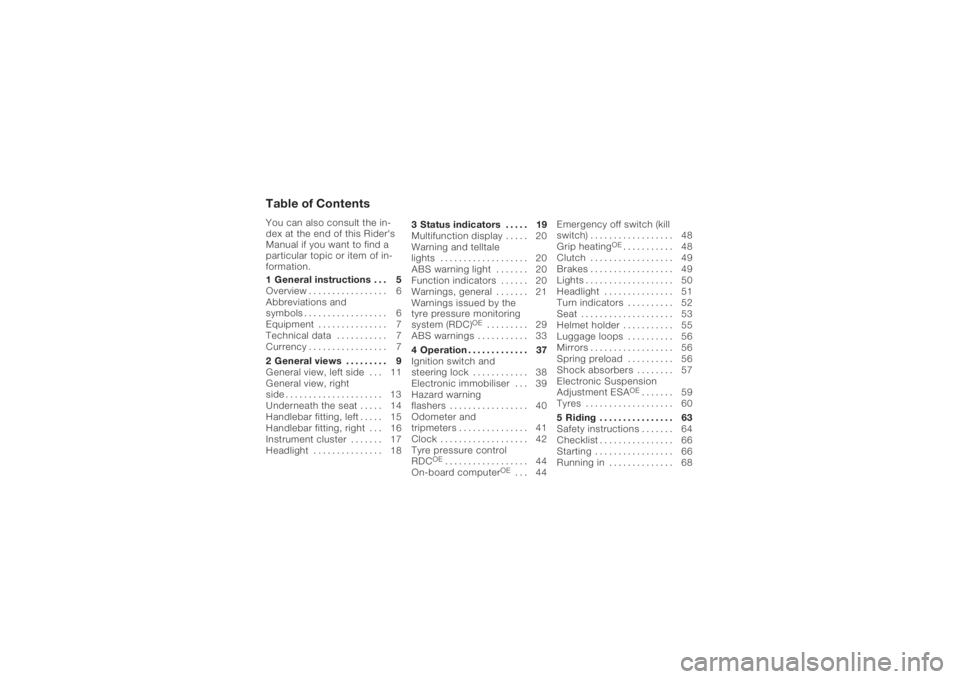
Table of ContentsYou can also consult the in-
dex at the end of this Rider's
Manual if you want to find a
particular topic or item of in-
formation.
1 General instructions . . . 5
Overview . ................ 6
Abbreviations and
symbols . . . ............... 6
Equipment ............... 7
Technical data ........... 7
Currency . . ............... 7
2 General views . . . . . .... 9
General view, left side . . . 11
General view, right
side ..................... 13
Underneath the seat . . . . . 14
Handlebar fitting, left . . . . . 15
Handlebar fitting, right . . . 16
Instrument cluster . . . . . . . 17
Headlight . .............. 18 3 Status indicators . . . . . 19
Multifunction display . . . . . 20
Warning and telltale
lights . . . . .
.............. 20
ABS warning light . . . . . . . 20
Function indicators . . . . . . 20
Warnings, general . . . . . . . 21
Warnings issued by the
tyre pressure monitoring
system (RDC)
OE
......... 29
ABS warnings . .......... 33
4 Operation . . . .......... 37
Ignition switch and
steering lock . . .......... 38
Electronic immobiliser . . . 39
Hazard warning
flashers . . . .............. 40
Odometer and
tripmeters . .............. 41
Clock . . . . . .............. 42
Tyre pressure control
RDC
OE
.................. 44
On-board computer
OE
... 44 Emergency off switch (kill
switch) . . . .
.............. 48
Grip heating
OE
........... 48
Clutch . . . . .............. 49
Brakes . . . . .............. 49
Lights . . . . . .............. 50
Headlight . .............. 51
Turn indicators .......... 52
Seat . . . . . . .............. 53
Helmet holder . .......... 55
Luggage loops .......... 56
Mirrors . . . . .............. 56
Spring preload .......... 56
Shock absorbers . . . . . . . . 57
Electronic Suspension
Adjustment ESAOE
....... 59
Tyres . . . . . .............. 60
5 Riding . . .............. 63
Safety instructions . . . . . . . 64
Checklist . . .............. 66
Starting . . . .............. 66
Running in .............. 68
Page 5 of 163
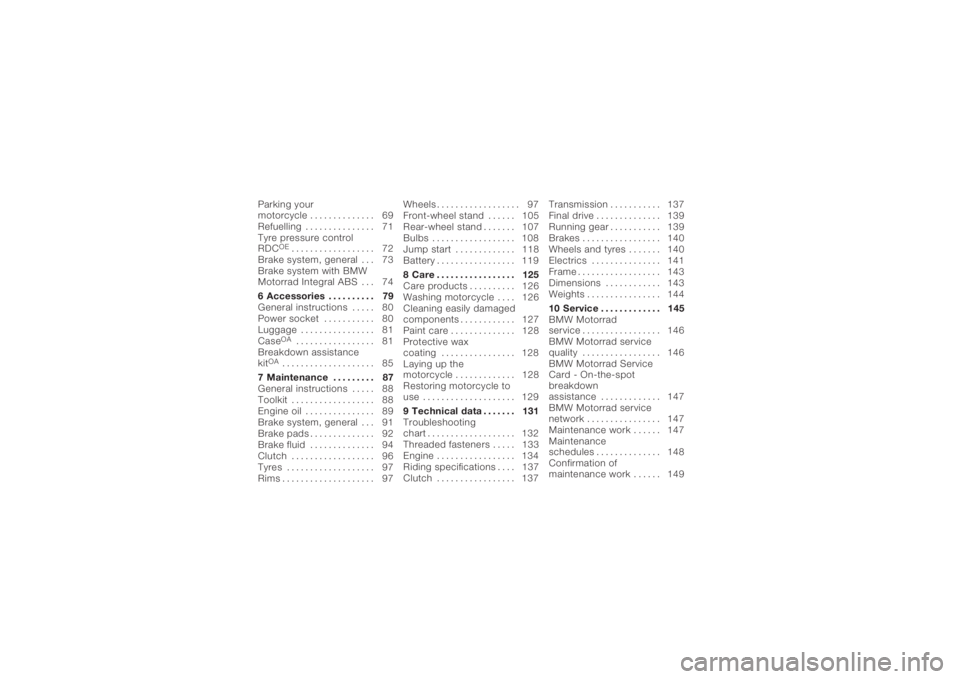
Parking your
motorcycle . . . ........... 69
Refuelling . . . . . .......... 71
Tyre pressure control
RDC
OE
.................. 72
Brake system, general . . . 73
Brake system with BMW
Motorrad Integral ABS . . . 74
6 Accessories .......... 79
General instructions . . . . . 80
Power socket . .......... 80
Luggage . . . . . . .......... 81
CaseOA
................. 81
Breakdown assistance
kit
OA
.................... 85
7 Maintenance . . . . . . . . . 87
General instructions . . . . . 88
Toolkit . ................. 88
Engine oil . . . . . .......... 89
Brake system, general . . . 91
Brake pads . . . . .......... 92
Brake fluid . . . . .......... 94
Clutch . ................. 96
Tyres . . ................. 97
Rims . . . ................. 97 Wheels .
................. 97
Front-wheel stand . ..... 105
Rear-wheel stand . . ..... 107
Bulbs . . ................ 108
Jump start . . . . ......... 118
Battery . ................ 119
8 Care . ................ 125
Care products . ......... 126
Washing motorcycle . . . . 126
Cleaning easily damaged
components . . . ......... 127
Paint care . . . . . ......... 128
Protective wax
coating ................ 128
Laying up the
motorcycle . . . . ......... 128
Restoring motorcycle to
use .................... 129
9 Technical data . . ..... 131
Troubleshooting
chart . . . ................ 132
Threaded fasteners ..... 133
Engine . ................ 134
Riding specifications . . . . 137
Clutch . ................ 137 Transmission . .
......... 137
Final drive . . . . . ......... 139
Running gear . . ......... 139
Brakes . ................ 140
Wheels and tyres . . ..... 140
Electrics . . . . . . ......... 141
Frame . . ................ 143
Dimensions . . . ......... 143
Weights ................ 144
10 Service . . . . ......... 145
BMW Motorrad
service . ................ 146
BMW Motorrad service
quality . ................ 146
BMW Motorrad Service
Card - On-the-spot
breakdown
assistance . . . . ......... 147
BMW Motorrad service
network ................ 147
Maintenance work . ..... 147
Maintenance
schedules . . . . . ......... 148
Confirmation of
maintenance work . ..... 149
Page 13 of 163

General view, left side1Adjuster for headlight
beam throw ( 52)
2 Clutch-fluid reservoir
( 96)
3 Adjuster, spring preload,
rear ( 57)
4 Seat lock beneath rear
light ( 53)
5 Adjuster, rear shock ab-
sorber ( 58)
6 Power socket ( 80)
211zGeneral views
Page 39 of 163
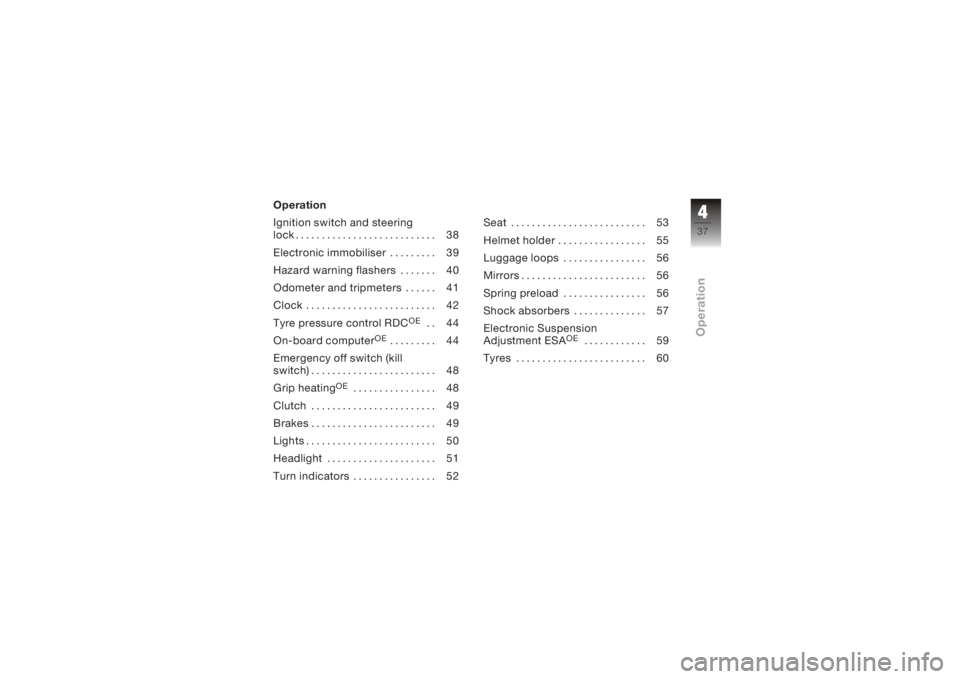
Operation
Ignition switch and steering
lock . . . . . . . . . . . . . . . . . . . . . . . . . . . 38
Electronic immobiliser . . . . . . . . . 39
Hazard warning flashers . . . . . . . 40
Odometer and tripmeters . . . . . . 41
Clock . . . . . . . . . . . . . . . . . . . . . . . . . 42
Tyre pressure control RDC
OE
.. 44
On-board computer
OE
......... 44
Emergency off switch (kill
switch) . . . . . . . . . . . . . . . . . . . . . . . . 48
Grip heating
OE
................ 48
Clutch . . . . . . . . . . . . . . . . . . . . . . . . 49
Brakes . . . . . . . . . . . . . . . . . . . . . . . . 49
Lights . . . . . . . . . . . . . . . . . . . . . . . . . 50
Headlight . . . . . . . . . . . . . . . . . . . . . 51
Turn indicators . . . . . . . . . . . . . . . . 52 Seat . . . . . . . . . . . . . . . . . . . . . . . . . . 53
Helmet holder . . . . . . . . . . . . . . . . . 55
Luggage loops . . . . . . . . . . . . . . . . 56
Mirrors . . . . . . . . . . . . . . . . . . . . . . . . 56
Spring preload . . . . . . . . . . . . . . . . 56
Shock absorbers . . . . . . . . . . . . . . 57
Electronic Suspension
Adjustment ESA
OE
............ 59
Tyres . . . . . . . . . . . . . . . . . . . . . . . . . 60
437zOperation
Page 51 of 163
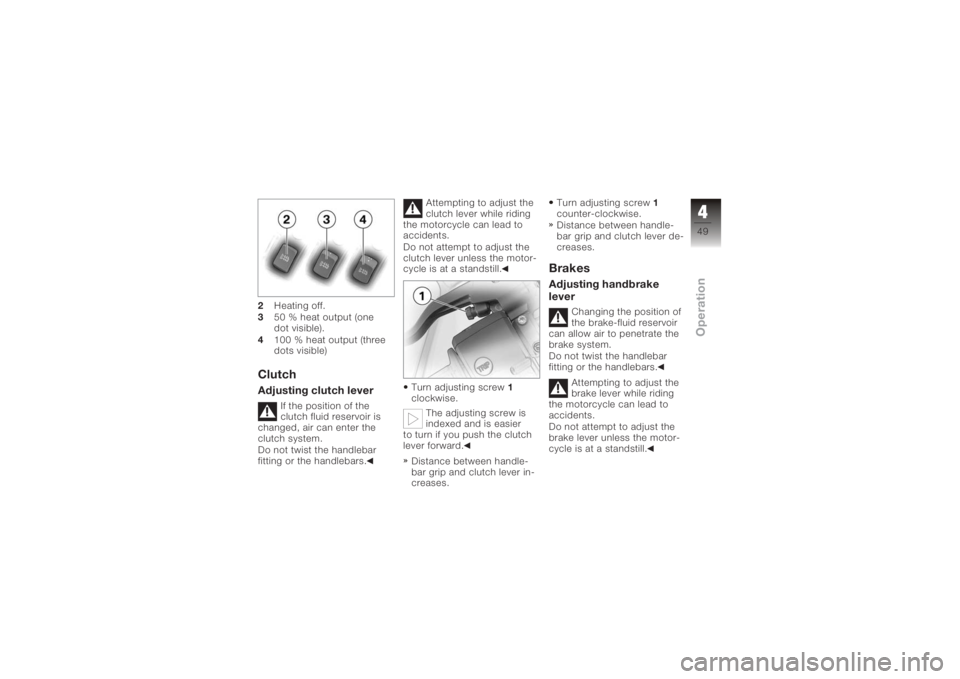
2Heating off.
3 50 % heat output (one
dot visible).
4 100 % heat output (three
dots visible)ClutchAdjusting clutch lever
If the position of the
clutch fluid reservoir is
changed, air can enter the
clutch system.
Do not twist the handlebar
fitting or the handlebars. Attempting to adjust the
clutch lever while riding
the motorcycle can lead to
accidents.
Do not attempt to adjust the
clutch lever unless the motor-
cycle is at a standstill.
Turn adjusting screw 1
clockwise.
The adjusting screw is
indexed and is easier
to turn if you push the clutch
lever forward.
Distance between handle-
bar grip and clutch lever in-
creases. Turn adjusting screw
1
counter-clockwise.
Distance between handle-
bar grip and clutch lever de-
creases.
BrakesAdjusting handbrake
lever
Changing the position of
the brake-fluid reservoir
can allow air to penetrate the
brake system.
Do not twist the handlebar
fitting or the handlebars.
Attempting to adjust the
brake lever while riding
the motorcycle can lead to
accidents.
Do not attempt to adjust the
brake lever unless the motor-
cycle is at a standstill.
449zOperation
Page 68 of 163
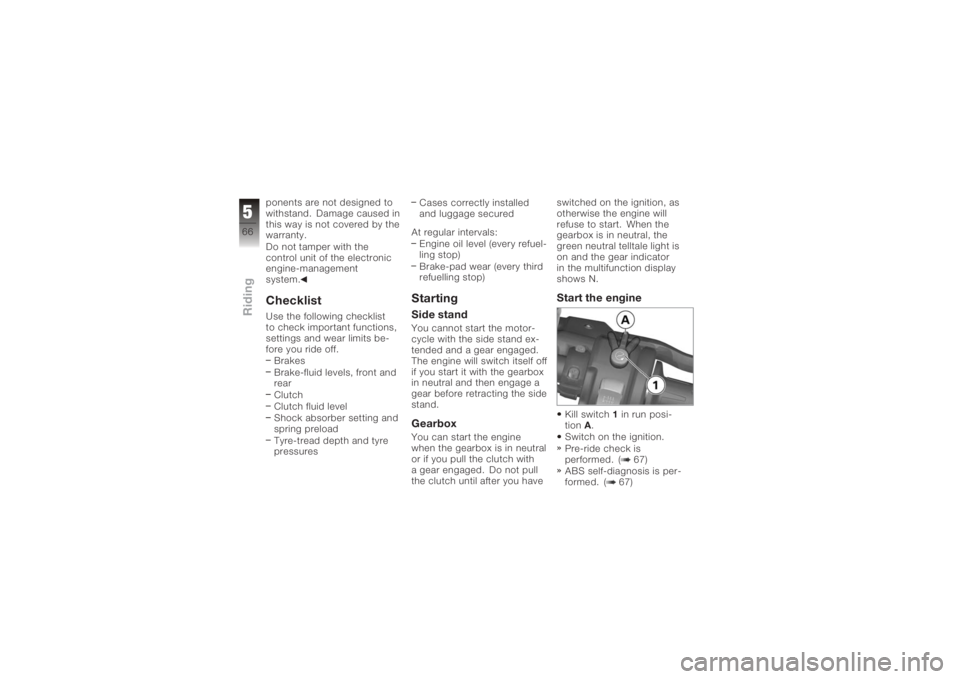
ponents are not designed to
withstand. Damage caused in
this way is not covered by the
warranty.
Do not tamper with the
control unit of the electronic
engine-management
system.ChecklistUse the following checklist
to check important functions,
settings and wear limits be-
fore you ride off.Brakes
Brake-fluid levels, front and
rear
Clutch
Clutch fluid level
Shock absorber setting and
spring preload
Tyre-tread depth and tyre
pressures Cases correctly installed
and luggage secured
At regular intervals: Engine oil level (every refuel-
ling stop)
Brake-pad wear (every third
refuelling stop)
StartingSide standYou cannot start the motor-
cycle with the side stand ex-
tended and a gear engaged.
The engine will switch itself off
if you start it with the gearbox
in neutral and then engage a
gear before retracting the side
stand.GearboxYou can start the engine
when the gearbox is in neutral
or if you pull the clutch with
a gear engaged. Do not pull
the clutch until after you have switched on the ignition, as
otherwise the engine will
refuse to start. When the
gearbox is in neutral, the
green neutral telltale light is
on and the gear indicator
in the multifunction display
shows N.
Start the engineKill switch
1in run posi-
tion A.
Switch on the ignition.
Pre-ride check is
performed. ( 67)
ABS self-diagnosis is per-
formed. ( 67)
566zRiding
Page 69 of 163
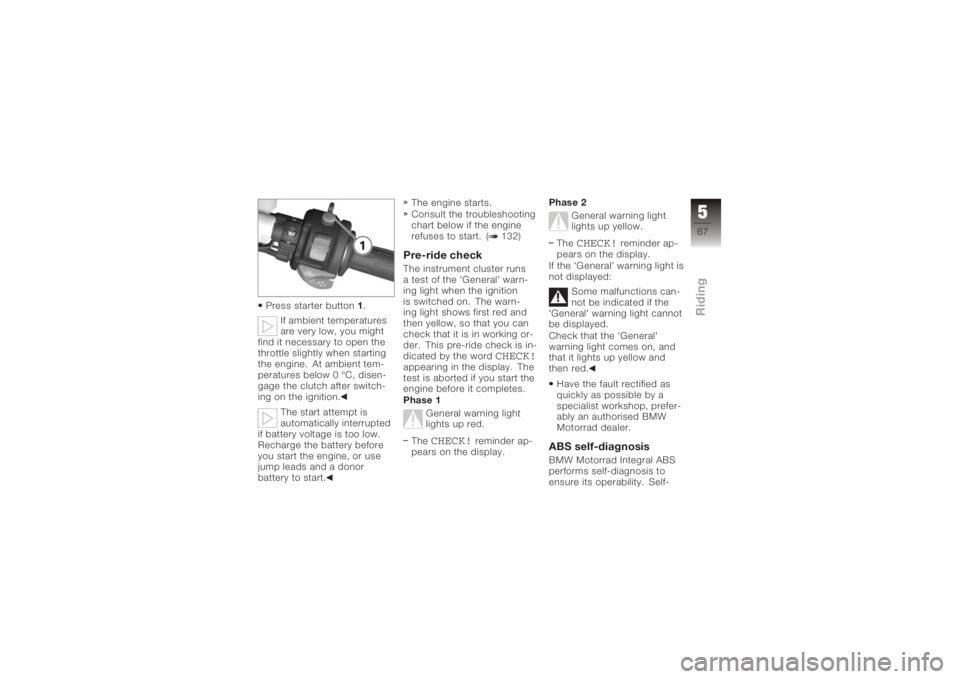
Press starter button1.
If ambient temperatures
are very low, you might
find it necessary to open the
throttle slightly when starting
the engine. At ambient tem-
peratures below 0 °C, disen-
gage the clutch after switch-
ing on the ignition.
The start attempt is
automatically interrupted
if battery voltage is too low.
Recharge the battery before
you start the engine, or use
jump leads and a donor
battery to start. The engine starts.
Consult the troubleshooting
chart below if the engine
refuses to start. ( 132)
Pre-ride checkThe instrument cluster runs
a test of the 'General' warn-
ing light when the ignition
is switched on. The warn-
ing light shows first red and
then yellow, so that you can
check that it is in working or-
der. This pre-ride check is in-
dicated by the word
CHECK!
appearing in the display. The
test is aborted if you start the
engine before it completes.
Phase 1
General warning light
lights up red.
The
CHECK!
reminder ap-
pears on the display. Phase 2
General warning light
lights up yellow.
The
CHECK!
reminder ap-
pears on the display.
If the 'General' warning light is
not displayed:
Some malfunctions can-
not be indicated if the
'General' warning light cannot
be displayed.
Check that the 'General'
warning light comes on, and
that it lights up yellow and
then red.
Have the fault rectified as
quickly as possible by a
specialist workshop, prefer-
ably an authorised BMW
Motorrad dealer.
ABS self-diagnosisBMW Motorrad Integral ABS
performs self-diagnosis to
ensure its operability. Self-
567zRiding
Page 76 of 163
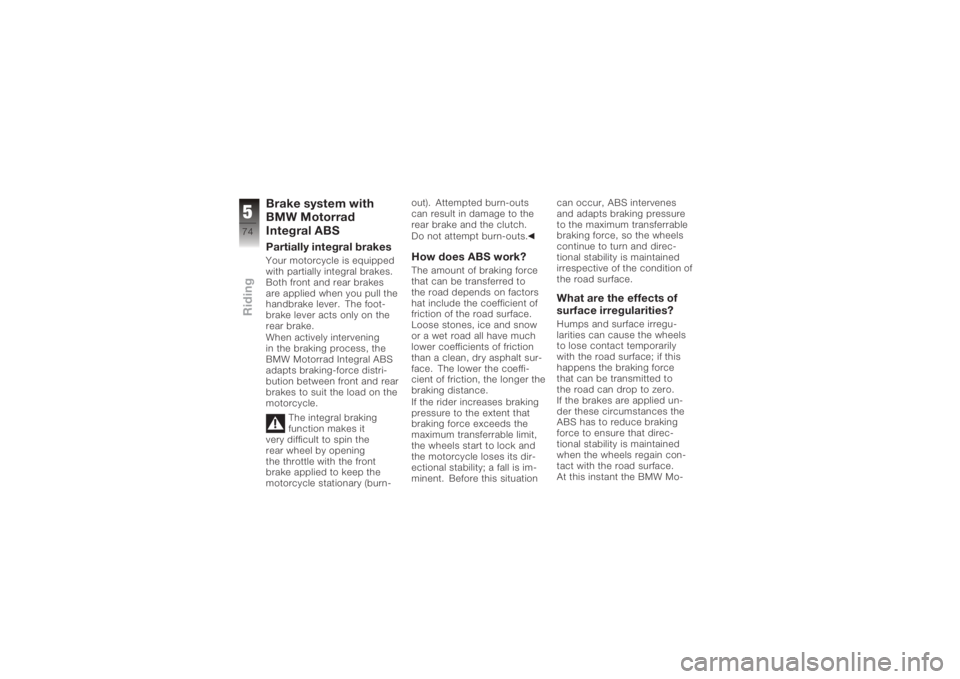
Brake system with
BMW Motorrad
Integral ABSPartially integral brakesYour motorcycle is equipped
with partially integral brakes.
Both front and rear brakes
are applied when you pull the
handbrake lever. The foot-
brake lever acts only on the
rear brake.
When actively intervening
in the braking process, the
BMW Motorrad Integral ABS
adapts braking-force distri-
bution between front and rear
brakes to suit the load on the
motorcycle.The integral braking
function makes it
very difficult to spin the
rear wheel by opening
the throttle with the front
brake applied to keep the
motorcycle stationary (burn- out). Attempted burn-outs
can result in damage to the
rear brake and the clutch.
Do not attempt burn-outs.
How does ABS work?The amount of braking force
that can be transferred to
the road depends on factors
hat include the coefficient of
friction of the road surface.
Loose stones, ice and snow
or a wet road all have much
lower coefficients of friction
than a clean, dry asphalt sur-
face. The lower the coeffi-
cient of friction, the longer the
braking distance.
If the rider increases braking
pressure to the extent that
braking force exceeds the
maximum transferrable limit,
the wheels start to lock and
the motorcycle loses its dir-
ectional stability; a fall is im-
minent. Before this situation
can occur, ABS intervenes
and adapts braking pressure
to the maximum transferrable
braking force, so the wheels
continue to turn and direc-
tional stability is maintained
irrespective of the condition of
the road surface.
What are the effects of
surface irregularities?Humps and surface irregu-
larities can cause the wheels
to lose contact temporarily
with the road surface; if this
happens the braking force
that can be transmitted to
the road can drop to zero.
If the brakes are applied un-
der these circumstances the
ABS has to reduce braking
force to ensure that direc-
tional stability is maintained
when the wheels regain con-
tact with the road surface.
At this instant the BMW Mo-
574zRiding